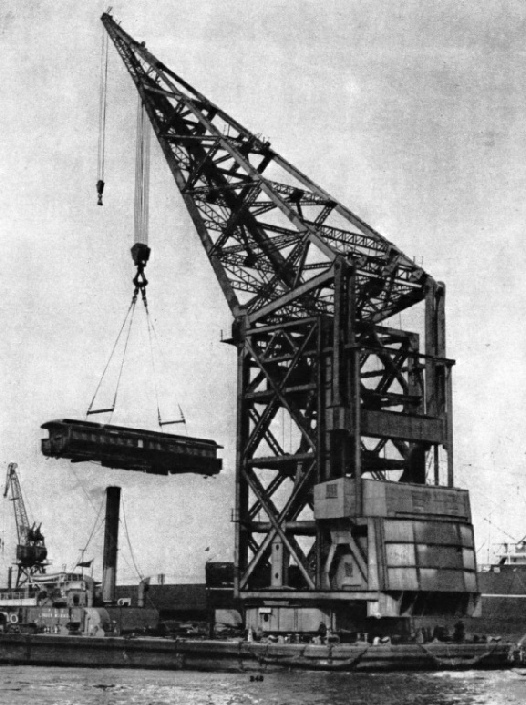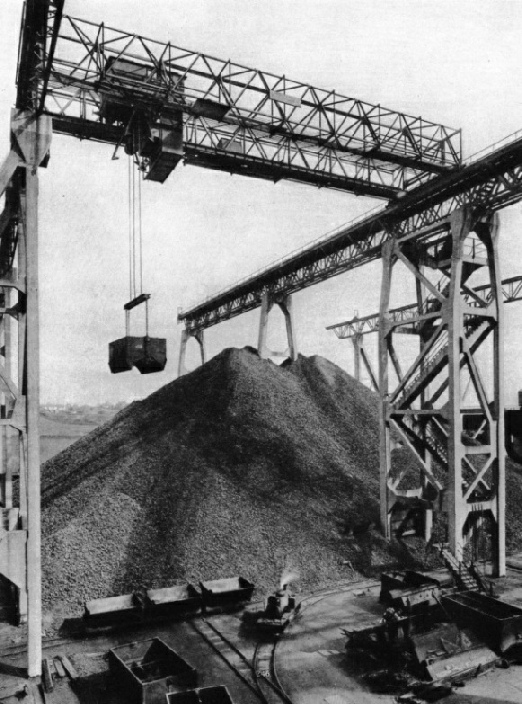

© Wonders of World Engineering 2014-




Part 8
Part 8 of Wonders of World Engineering was published on Tuesday 20th April 1937, price 7d.
Part 8 includes a photogravure supplement showing modern cranes at work. This illustrates the article on The Modern Crane.
The Cover
This week’s cover shows a giant crane at Haifa, the new port in Palestine. The recent expansion of Palestine's trade has necessitated the building of a harbour at Haifa, to supplement the ancient port of Jaffa.
You can read more on this in the article on Palestine's New Harbours; whilst another chapter in this issue describes The Modern Crane.
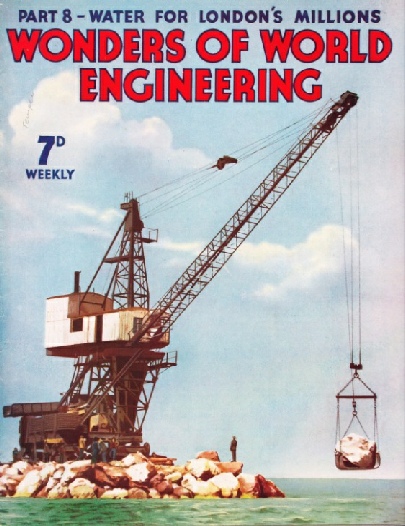
Contents of Part 8
Salvage Engineers at Work (Part 1)
Unusually complicated problems of engineering have to be solved by the salvage expert when he has to raise sunken vessels, whether small ships, ocean-going liners or battleships, from the bed of the sea. This chapter is concluded from part 7.
Water for London’s Millions
Nearly 300,000,000 gallons of water are consumed daily by the inhabitants of the area supplied by the Metropolitan Water Board, in whose various waterworks the water is stored, filtered and sterilized. In no sphere of human activity does the work of the engineer exert a more important influence than in the supply of water to large populations. The chemist’s work is, of course, no less important, but he and the engineer must work in the closest co-operation. A plentiful supply of pure water is the most important factor in the maintenance of a high standard of health. There can be physical fitness schemes, more hygienic living conditions, more open spaces, shorter working hours and improved places in which to work, but these would be useless without a pure water supply. The larger the supply the more difficult the problems that confront the engineer. This chapter deals with London’s water supply. This chapter gives a complete description of this great organization and of the part the engineer plays and has played in the supplying of a large city with its water supply.
The Modern Crane
From the early type of windlass known to the Chinese thousands of years ago there have developed numerous types of crane, stationary and mobile, each designed for a special purpose. This chapter includes a photogravure supplement illustrating various types of modern cranes.
The Modern Crane (photogravure supplement)
The Modern Crane: Photogravure Supplement
ELECTRIC FLOATING JIB CRANE in Vigo Harbour, Spain. This crane lifts 60 tons at a radius of 49 feet and is fitted with an auxiliary hoist which lifts 10 tons at a radius of
75 ft 6 in. The pontoon is propelled by steam power, which is used also to drive the dynamo supplying current for operating the crane The deck is specially stiffened to take a deck load of 60 tons.
Contents of Part 8 (continued)
Palestine’s New Harbours
The recent expansion of Palestine’s trade has been assisted by the work of engineers who have developed large-scale harbour works at Haifa and Jaffa, where the work has included the building of sea walls and the reclamation of land.
LMS Pacific Express Locomotive
Among the most successful British express passenger locomotives are the Pacifics of the London, Midland & Scottish Railway. One of these, No. 6201 Princess Elizabeth, is illustrated in this article. This engine was built in 1933. The standard engines of this type are four-cylinder simples. The cylinders have a diameter of 16¼ in and a stroke of 28 in, actuated by Walschaerts valve-gear, with 7¼ in travel. This is the fourth article in the series on Modern Engineering Practice.
Early Steam Coaches
The story of steam coaches which were tried before railways were developed is romantic and important. It was in road transport that the earliest experiments in the propulsion of carriages by steam power first showed signs of success.
Across the Andes (Part 1)
In the face of unparalleled difficulties, aggravated by the climate, engineers in South America have succeeded in building railways across the world’s second highest mountain range. These include the Peruvian Central Railway, in Peru, and the Transandine Railway, between the Argentine and Chile. One of the most formidable challenges to the engineer has come from the Andes. The engineer has not yet conquered the Andes. He has triumphed here and there, often at the cost of valuable lives. The story of man’s trials and triumphs in his onslaught on the Andes is in this chapter, which is concluded in part 9. This is the second article in the series on Railway Engineers at Work.
The Modern Crane: Photogravure
Supplement - 3
LOADING A RAILWAY COACH weighing 30 tons and 63 feet long in the Royal Albert Dock, London. The huge floating crane belongs to the Port of London Authority. Called the London Mammoth, she is registered as a ship at Lloyd's. Propelled by twin screws, she has a gross tonnage of 1,580. She is 191 ft 7 in long and has a beam of 75 ft 3 in.
The Modern Crane: Photogravure
Supplement - 4
AN OVERHEAD ELECTRIC TRAVELLING CRANE. This photograph shows an electric overhead travelling crane, with a capacity of 7 tons, in operation at the Provan Gasworks of Glasgow Corporation. The span between the centres of the rails on which the crane runs is 82 feet. The crane has a height of 84 ft 6 in and is designed for handling coke in skips or grabs.
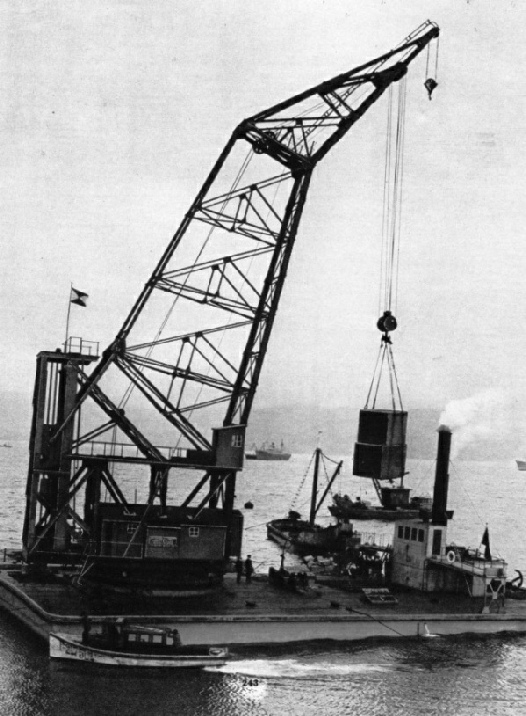
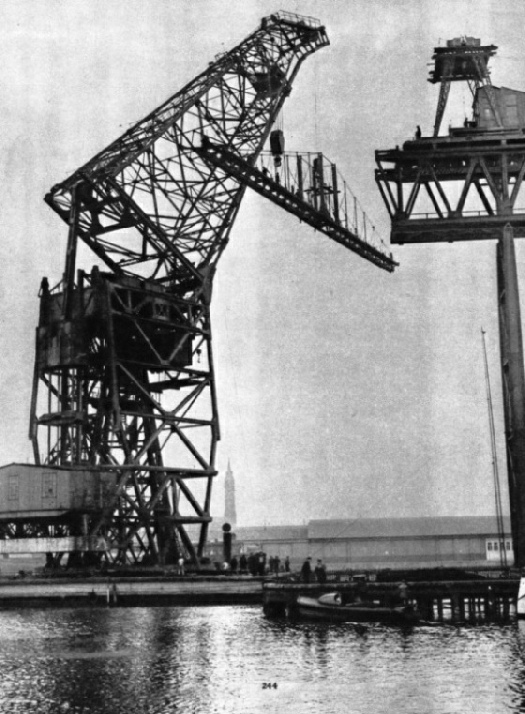
The Modern Crane: Photogravure
Supplement - 2
ONE CRANE LIFTS ANOTHER. This photograph shows a giant floating crane in a shipbuilder's yard at Belfast, Northern Ireland. The crane is removing the 200-feet span of an overhead gantry crane, so that it may be inspected and overhauled.
